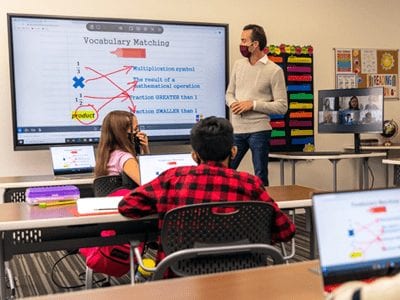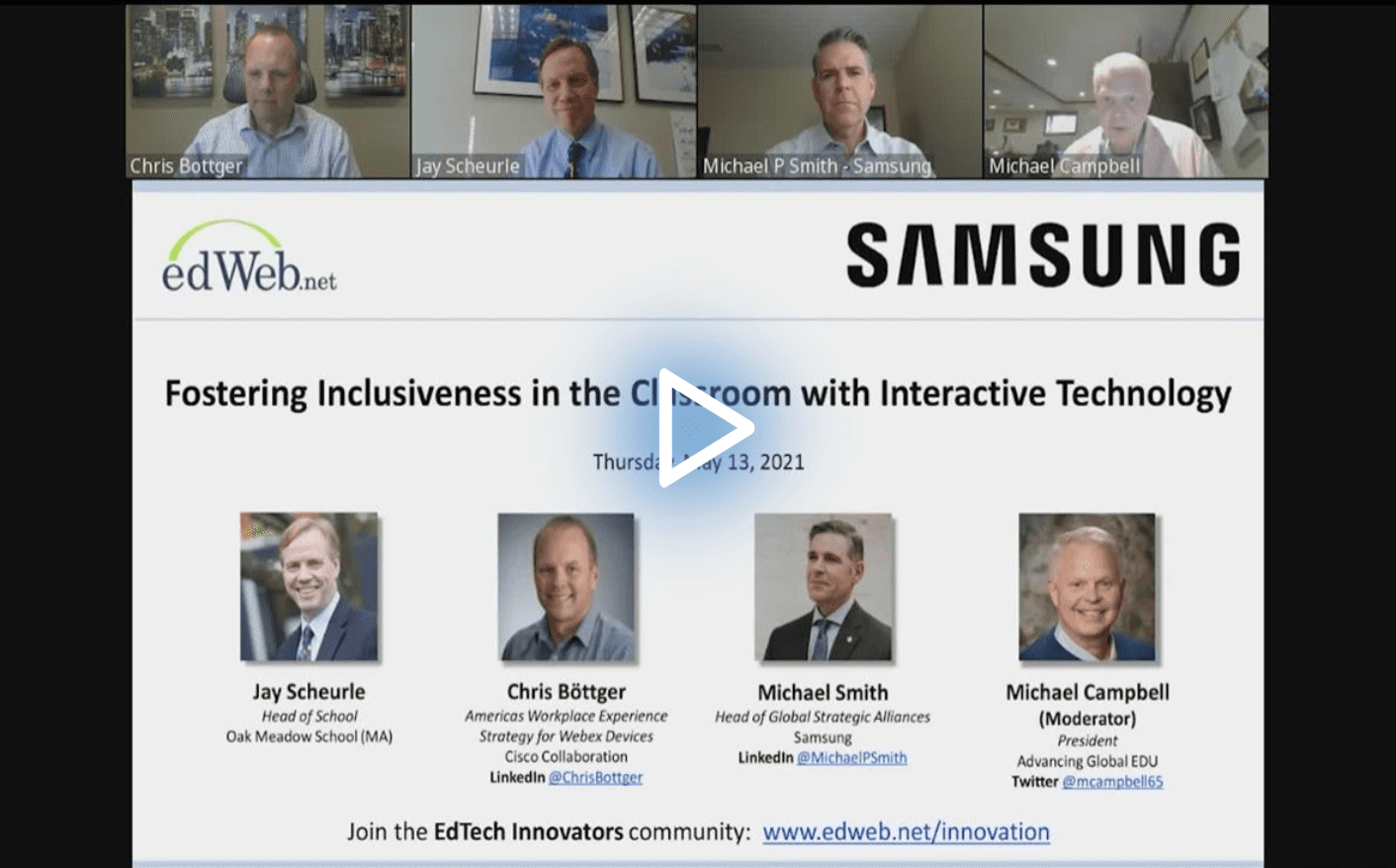Technology Brings All Students to School “Automagically”
Last year, Chris Böttger’s son spent fifth grade learning at home because of his disability, intractable chronic migraine. That was until COVID forced the school, Oak Meadow (MA), to shut down and go remote. Virtual learning ended up being the boy’s path “into the classroom.”
Technology, said Böttger, who is responsible for Workplace Experience Strategy for the Device Technology Group at Cisco, was the bridge to his son’s inclusion in the school environment.
Böttger was among educational and tech panelists on a recent edLeader Panel, sponsored by Samsung, who described Oak Meadow’s journey to engage all students through technology that maximized teaching and learning.
Concerns and Possibilities
This year, with schools reopening post-pandemic, many students returned to Oak Meadow, but about 30% did not. Hybrid learning became a must, but not without some trepidation.
Jay Scheurle, Oak Meadow’s Head of School, said that even with the school’s distance learning success during COVID, the blended arrangement stirred up concerns.
Teachers wondered how they would connect with students in their homes, get content to them and keep them engaged. Parents worried whether their children would have access to technology. Students opting to learn at home fretted over being isolated and not part of the learning community.
Oak Meadow took a technological leap of faith—it established a system of tools and programs that brought together distant and on-site learners, making them feel as if they were all in the same space at the same time.
Getting the Technology Right and Together “Automagically”
The key to Oak Meadow’s immersive and engaging hybrid learning experience was the thoughtful integration of technology and curriculum. Or what Michael Smith, Head of Global Strategic Alliances at Samsung, described as “automagically” connecting devices to “talk to each other” in order to work together.
“Technology should not be a disruption,” emphasized Smith. “Technology, when done right, should be integral to how you teach and learn and enhance the process throughout. Our passion for inclusive learning is making devices speak to one another in a meaningful way to make the teachers’ job easier and the students’ learning better.”
The array of systems, tools and apps at Oak Meadow might appear dizzying. But, that’s not the case. Scheurle said that the technology has allowed for almost seamless instruction and learning that is now second nature to the students and teachers.
The school’s setup is impressive:
- Classrooms have Samsung interactive boards or displays connected to the CISCO Webex Board, which provides a whiteboard, video or audio conferencing and the ability to annotate shared content. The display captures everything that is done on the whiteboard and is then translated and transcribed. If students cannot capture content in real time, they can use the transcriptions. (Smith said that his son, who is on the autism spectrum, relies on transcripts, which give him the ability to study and review at his own pace.)
- The display technology also connects to mobile devices, tablets, iPads, iPhones, whatever learners bring to the classroom. If a student brings a tablet to class or uses one at home and is connected via Webex, he or she can integrate and interact with the whiteboard without getting out of their seat. Oak Meadow students have Chromebooks with integration limitations, but can still interact with and annotate the screens.
- Teachers use Google Classroom and other web-based apps across subject areas, which can also be displayed and stored on the board. Math and science teachers, who do not teach in the school, use the boards to come “into” the classroom from their homes.
- Classrooms had large screens that projected at-home students into the class, making them part of the class. Böttger said that this technology makes his son feel like he’s sitting in the classroom.
- And then there’s the Cisco Webex Room Kit camera, which, noted Scheurle, was a big part of helping the school meet its educational goals. An accompanying control panel allows users to adjust the camera’s position for enhanced video collaboration and integration.
“We’ve gotten to a place where the class just moves along and hums,” Scheurle described. “And the kids at home and the kids at school, this is the environment they’re in. They forget that all this amazing technology is happening around them because they’ve been allowed to go back into what they’re supposed to be doing, which is focusing on learning.”
Outcomes, Impact and the Future
Smith noted that the Oak Meadow experience is not just about some good pandemic lessons learned. It is a step to future-proofing the school community. That involves building on the schools’ achievements, including capturing and integrating a full curriculum in a tech-based environment, building a cadre of teachers who learned to rely on and appreciate tools they believed would be complex and hard to manage, creating stronger socio-emotional connections between students and teachers and, of course, enabling every student to participate in a rich learning experience.
“I see real opportunities for us to leverage this technology and these formats and these presentations for all kinds of really rich learning that continue to connect our kids,” Scheurle said. “Not only for the kids that may have to stay at home, but for the kids that are in the classroom to be connected into the world that they’re part of.”
And further out in the future? There are many sunny scenarios. More inclusive learning environments through technology, more devices being brought into the classroom and more asynchronicity in the way people learn. Maybe micro lesson plans translated to multiple devices or transcriptions of lessons in hundreds of languages for ELL students. And then there’s video conferencing and presentations with experts, organizations and schools from around the world.
All possible? For Oak Meadow, which accelerated the curve of innovation in just over 10 months? Absolutely.
This edWeb broadcast was sponsored by Samsung.
Watch the Recording Listen to the Podcast
About the Presenters
Jay Scheurle holds a B.A. in public affairs from Indiana University and an M.A. in educational leadership from Columbia University. Prior to joining Oak Meadow in 2018, Jay was Head of School at Miami Valley School and Chesapeake Academy. Jay is currently pursuing his Administrator Montessori certification through the West Side Montessori School – Teacher Education Program in New York City. He enjoys being a part of the Oak Meadow community because, “The education of children is the most important and meaningful work in the world today. The children at Oak Meadow are exceptionally kind and intellectually curious. There is a wonderful spirit of community and caring shared by teachers, students, parents, and alumni.”
Chris Böttger is responsible for Workplace Experience Strategy for the Device Technology Group at Cisco. He has taken the Building Management, Video Collaboration and IoT Networking Foundation to create a Human Machine Interface (HMI) strategy that can drive users in real time to improve engagement and the overall workplace experience.
Michael Smith is a visionary leader with an extensive background in marketing, business development and strategic sales leadership. Michael’s current role is centered around strategic alliance relationships for Samsung Display with leading technology companies to deliver state-of-the-art solutions for education and the enterprise space. His mission is to leverage these relationships to foster better teaching experiences for students and teachers alike.
About the Moderator
Michael Campbell’s passion for improving education through technology and digital literacy has helped private and not-for-profit organizations create solutions that support the learning community. For over 20 years, Michael has held executive, marketing management and sales positions spanning the K-12, higher education, corporate training, technology and publishing industries. Michael has held leadership positions in sales and marketing with Learning Bird, Follett Software Company, ETA hand2mind, Pearson, Cengage and McGraw-Hill Higher Education. Michael currently leads a team of advisors at Advancing Global EDU who focus on helping companies and organizations succeed in the business of education. Michael is an elected trustee for the Fox River Grove, Illinois library district, the president of the board for the RAILS Library Consortium in Illinois, and sits on the executive committee of the Girl Scouts of Northern Illinois.
Join the Community
EdTech Innovators is a free professional learning community on edWeb.net that presents edWebinars with educators who are exceptional in their use of technology to support teaching and learning.
Samsung offers brilliant display solutions so schools can easily create more captivating and interactive learning environments in the classroom and across campus.
Samsung—simply brilliant.
The summary of this presentation was written by Michele Israel.
Michele Israel writes about the ideas and best practices that are shared in edWeb’s edWebinars so they can spread innovative and best practices to the education community. Michele owns Michele Israel Consulting, LLC, which serves large and small educational, non-profit, media, corporate, eLearning, and blended learning organizations to bolster products and programs. Her rich career spans over 25 years of successfully developing educational materials and resources, designing and facilitating training, generating communication materials and grant proposals, and assisting in organizational and program development. In addition to lesson plans and other teacher resources, Michele’s portfolio includes published articles covering a range of educational and business topics.




Comments are closed.